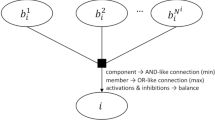Abstract
Biochemical networks are a particular kind of biological networks which describe the cell metabolism and regulate various biological functions, from biochemical pathways to cell growth. The relationship between structure, function and regulation in complex cellular networks is still a largely open question. This complexity calls for proper mathematical models and methods relating network structure and functional properties. In this paper we focus on the problem of drug targets’ identification by detecting network alteration strategies which lead to a cell functionality loss. We propose a mathematical model, based on a bi-level programming formulation, to obtain the minimum cost disruption policy through the identification of specific gene deletions. These deletions represent drug target identification of new drug treatments for hindering bacterial infections.
Similar content being viewed by others
References
Alberghina, L., Westerhoff, H.V. (eds.): Systems Biology: Definitions and Perspectives. Springer, New York (2005)
Bard, J.F.: Practical Bilevel Optimization Algorithms and Applications. Kluwer Academic, Dordrecht (1998)
Becker, S.A., Palsson, B.Ø.: Genome-scale reconstruction of the metabolic network in Staphylococcus aureus N315: an initial draft to the two-dimensional annotation. BMC Microbiol. 5(8) (2005)
Burgard, A.P., Pharkya, P., Maranas, C.D.: OptKnock: a bilevel programming framework for identifying gene knockout strategies for microbial strain optimization. Biotechnol. Bioeng. 84(6), 647–657 (2003)
Chen, B.S., Li, C.W.: Analysing microarray data in drug discovery using systems biology. Expert Opinion Drug Discovery 2, 755–768 (2007)
Chu, L.H., Chen, B.S.: Construction of cancer-perturbed protein-protein interaction network for discovery of apoptosis drug targets. BMC Systems Biology 2-56- (2008)
Dempe, S.: Foundations of Bilevel Programming. Kluwer Academic, Dordrecht (2002)
Edwards, J.S., Palsson, B.O.: How will bioinformatics influence metabolic engineering? Biotechnol. Bioeng. 58, 162–169 (1998)
Fortuny-Amat, J., McCarl, B.: A representation and ecnomic interpretation of a two-level programming problem. J. Oper. Soc. 32 783–792 (1981)
Haus, U., Klamt, S., Stephen, T.: Computing knock-out strategies in metabolic networks. J. Comput. Biol. 15, 259–268 (2008)
Heinrich, R., Schuster, S.: The Regulation of Cellular Systems. Chapman and Hall, New York (1996)
Kadirkamanathan, V., Yang, J., Billings, S.A., Wright, P.C.: Markov chain Monte Carlo algorithm based metabolic flux distribution analysis on Corynebacterium glutamicum. Bioinformatics 22(21), 2681–2687 (2006)
Kitano, H., et al.: Foundations of Systems Biology. MIT, Cambridge (2001)
Klamt, S., Gilles, E.D.: Minimal cut sets in biochemical reaction networks. Bioinformatics 20, 226–234 (2004)
Kotaka, M., Dhaliwal, B., Ren, J., Nichols, C.E., Angell, R., Lockyer, M., Hawkins, A.R., Stammers, D.K.: Structures of S. aureus thymidylate kinase reveal an atypical active site configuration and an intermediate conformational state upon substrate binding. Protein Sci. 15, 774–784 (2006)
Lanzeni, S., Messina, E., Archetti, F.: Graph models and mathematical programming in biochemical networks analysis and metabolic engineering design. Comput. Math. Appl. 55(5), 970–983 (2008)
Moore, J.T., Bard, J.F.: The mixed integer linear bilevel programming problem. Oper. Res. 38(5), 911–921 (1990)
Neidhardt, F.C.: Escherichia Coli and Salmonella. American Society for Microbiology Press, Washington DC (1996)
Palsson, B.O.: Systems Biology: Properties of Reconstructed Networks. Cambridge University Press, Cambridge (2006)
Paun, G., Sheng, Y.: On synchronization in P systems. Fundam. Inform. 38(4), 397–410 (1999)
Popova-Zeugmann, L.: Time petri nets for modelling and analysis of biochemical networks. Fundam. Inform. 67, 149–162 (2005)
Reed, J.L., Vo, T.D., Schilling, C.H., Palsson, B.Ø.: An expanded genome-scale model of Escherichia coli K-12 (iJR904 GSM/GPR). Genome Biol. 4(9), R54.1–R54.12 (2003)
Segre, D., Vitkup, D., Mc Church, G.: Analysis of optimality in natural and perturbed metabolic networks. PNAS 99(23) (2002)
Shlomi, T., Berkman, O., Ruppin, E.: Regulatory on/off minimization of metabolic flux changes after gene perturbations. PNAS 102(21), 7696–7700 (2005)
Thiele, I., Vo, T.D., Price, N.D., Palsson, B.Ø.: An expanded metabolic reconstruction of Helicobacter pylori (iIT341 GSM/GPR): an in silico genome-scale characterization of single and double deletion mutants. J. Bacteriol. 187(16), 5818–5830 (2005)
Tomlin, C.D.S.: The Pesticide Manual, 13th edn. The British Crop Protection Council, Croydon (2003)
Treble, D.H., Lamport, D.T.A., Peters, R.A.: The inhibition of plant Aconitate hydratase (aconitase) by fluorocitrate. Biochem. J. 85, 113–115 (1962)
Varma, A., Palsson, B.O.: Stoichiometric flux balance models quantitatively predict growth and metabolic by-product secretion in wild-type Escherichia coli W3110. Appl. Environ. Microbiol. 60, 3724–3731 (1994)
Vincente, L., Savard, G., Judice, J.: The discrete linear bilevel programming problem. J. Optim. Theory Appl. 89, 597–614 (1996)
Vogel, D.S., Axelrod, R.C.: Predicting the effects of gene deletion. SIGKDD Explorations 4(2), 101–103 (2002)
Author information
Authors and Affiliations
Corresponding author
Rights and permissions
About this article
Cite this article
Lulli, G., Messina, E., Archetti, F. et al. A Mathematical Model for Optimal Functional Disruption of Biochemical Networks. J Math Model Algor 9, 19–37 (2010). https://doi.org/10.1007/s10852-009-9118-0
Received:
Accepted:
Published:
Issue Date:
DOI: https://doi.org/10.1007/s10852-009-9118-0




